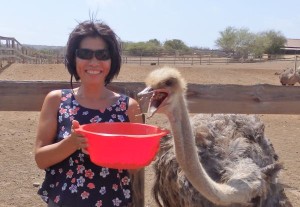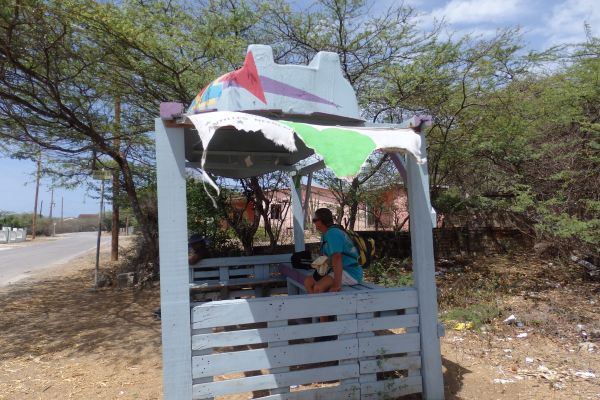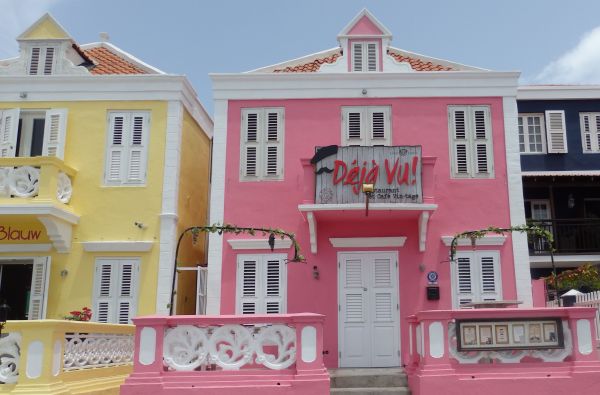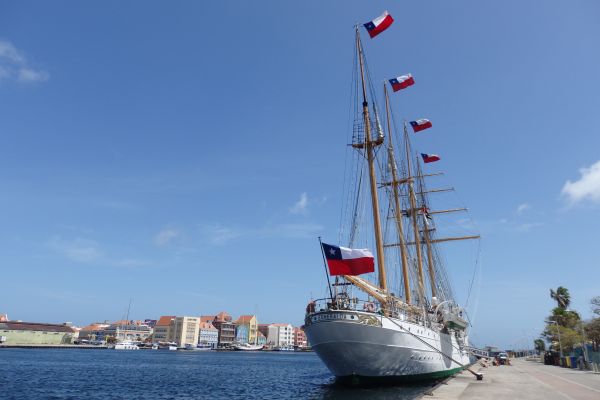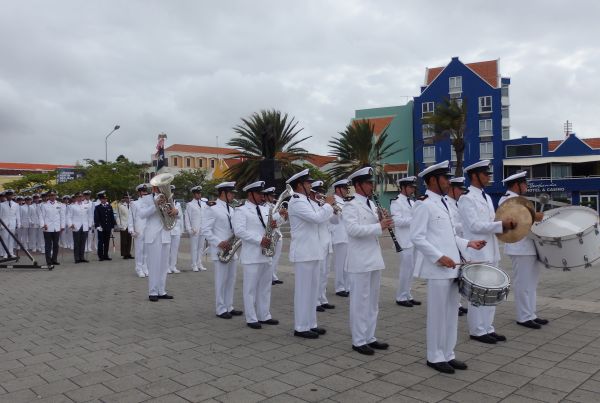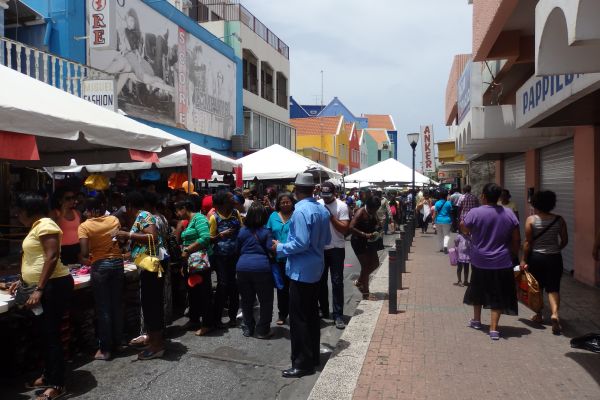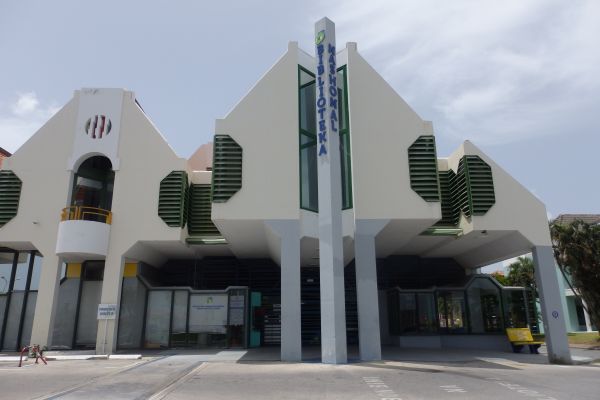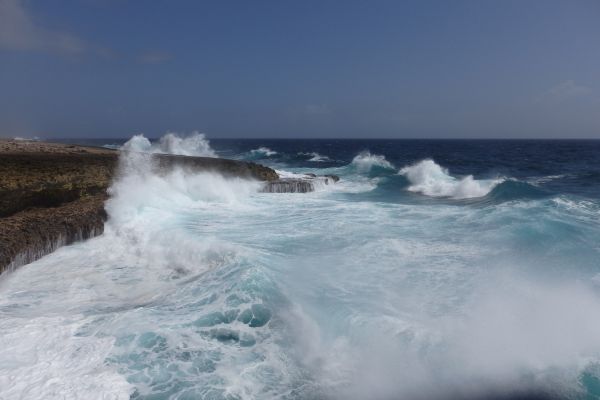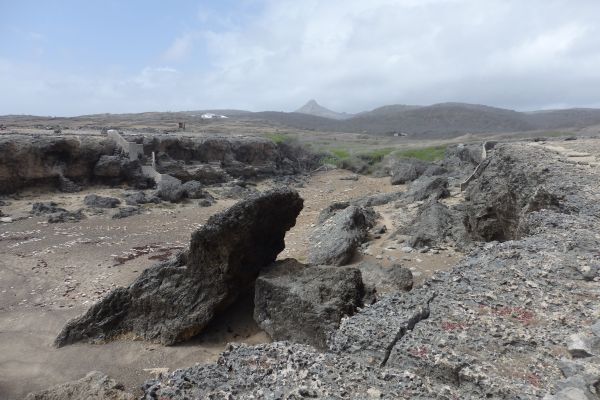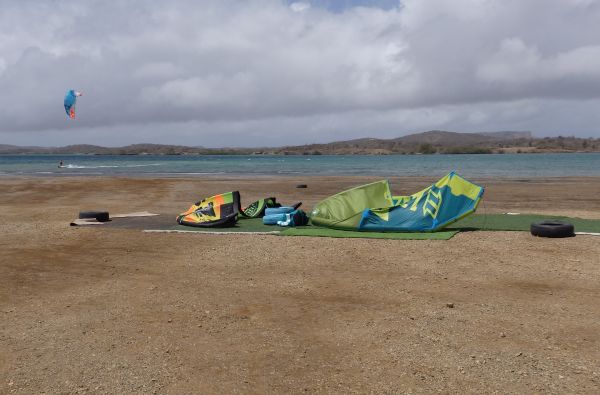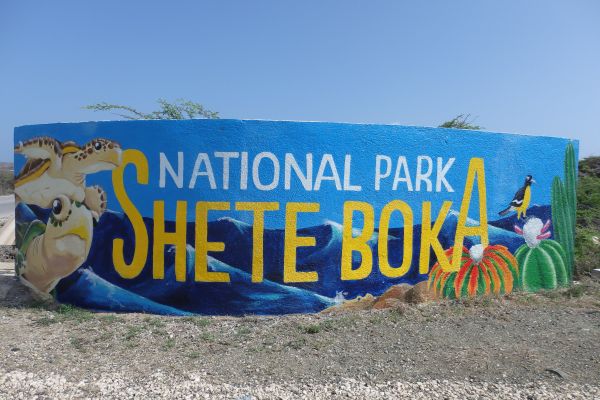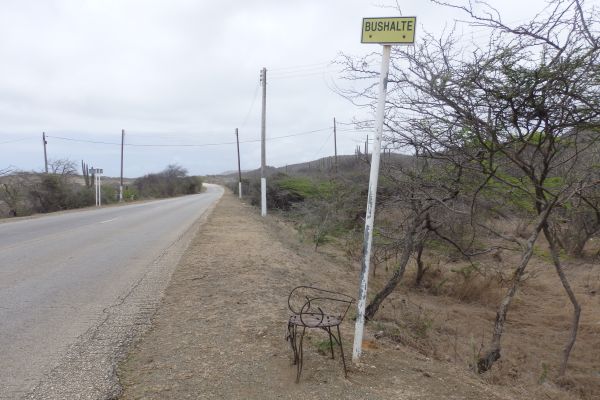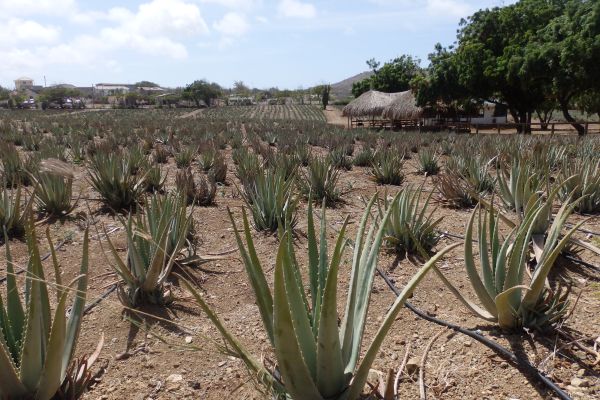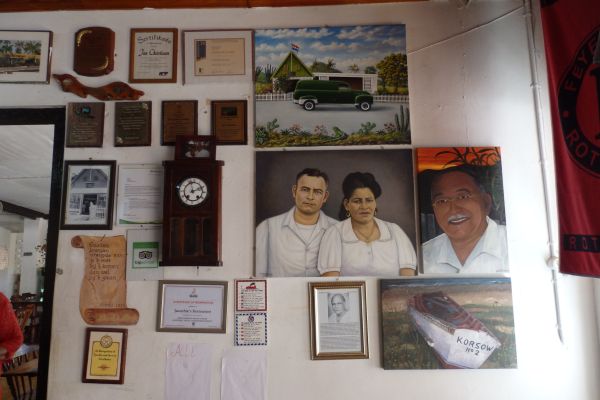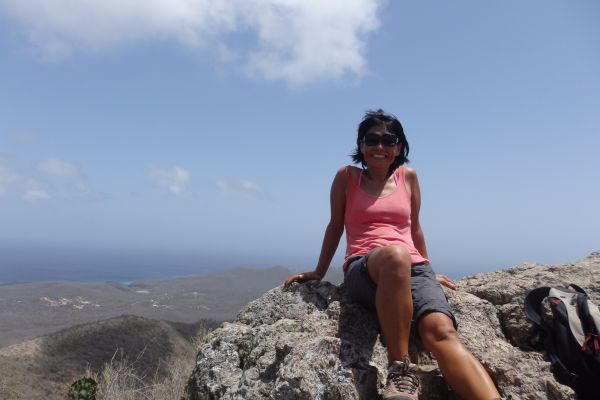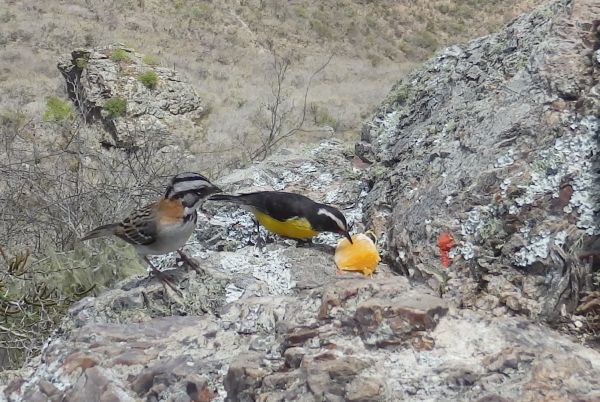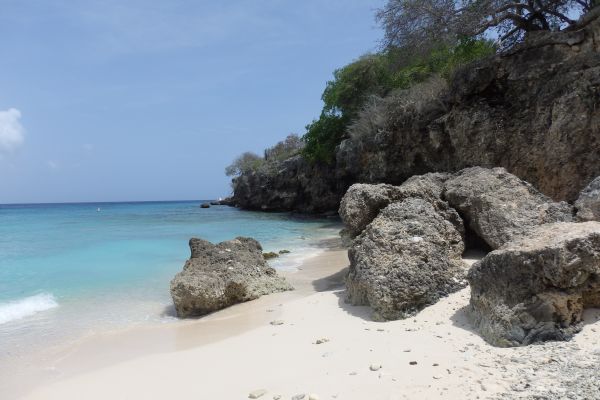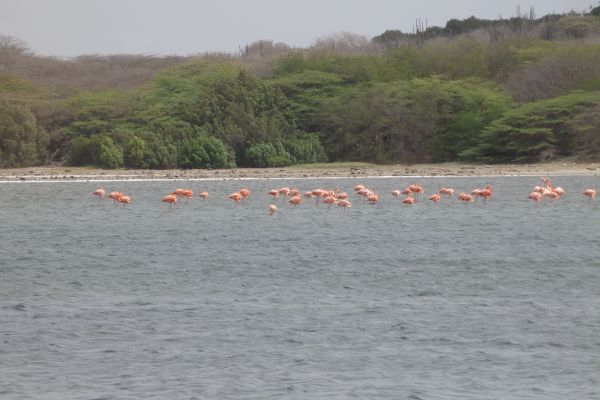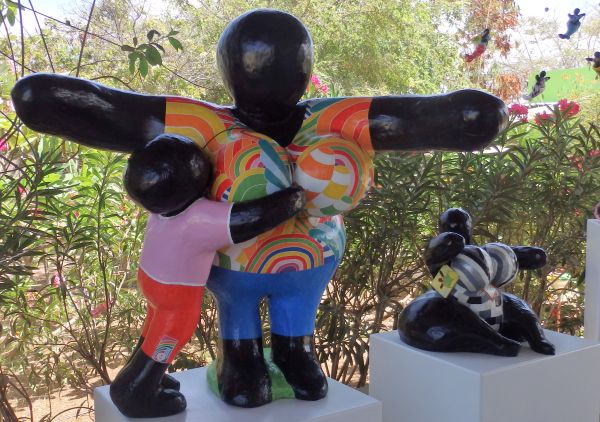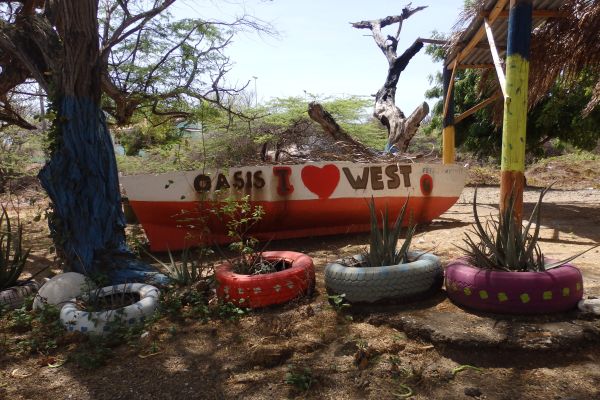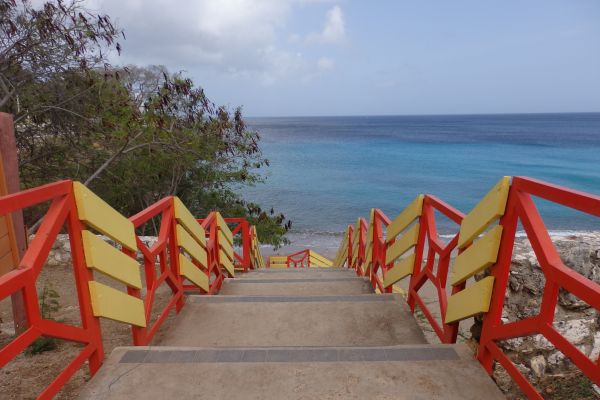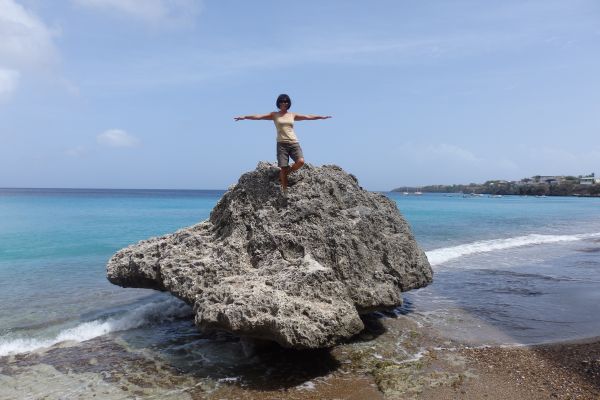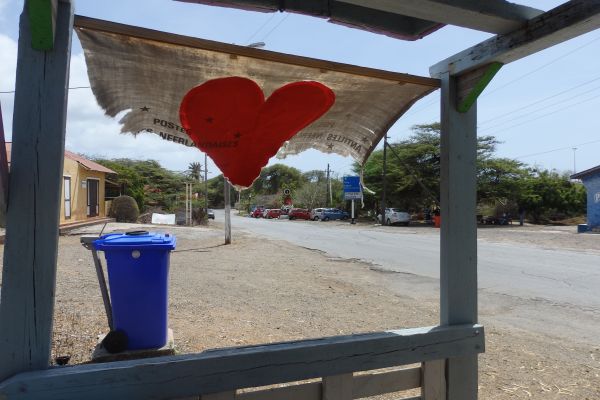‘Bon Bini’ means ‘Welcome’ and ‘Dushi’ means ‘Sweet’ in Papiamentu, the official language in Curacao, “originated from different African languages, complemented with words from Dutch, Spanish, English, and Portuguese.”
Sailboat for us seems like a water RV. The other day, John and I figured out that we sailed less than 10% of our total time since leaving North Carolina in November 2014. Sailing lets us go from one place to another place. Once we get there, we anchor, live on a boat, and travel the country. This is the remaining 90%. We are more nomadic travelers than sailors.
It rains little in Curacao so water is made from the sea water. Green grass almost doesn’t exist. It’s a dry island. There are lots of thorny plants and many types of cactus plants. When hiking, we periodically had to watch the path so as not to step on the thorns.
The wind blows every day between 11 (Force 4) to 33 knots (Force 7), as determined by the trade winds so the trees seem one sided, they are blown only in one direction their entire life. The average annual temperature here is about 28 Celsius (82 Fahrenheit). With the constant breeze, I like the Curacao weather very much. No bugs at the anchorage, terrific!
Windsurfing, SCUBA diving, beachcombing, and kite boarding are popular in Curacao. Many restaurants and bars offer happy hour specials. It’s touristic. Since it is one of the Netherlands, there are many tourists from Holland. Public transportation is convenient, relatively. One day while we were waiting for a bus, we realized the Dutch people are very tall. We googled and found the Netherlands are the tallest country, meaning the Dutch people are the tallest.
We plan to stay here for three months. The longer I stay here the more interesting places I want to visit. Curacao is not far from Miami. When visiting Curacao, make sure to stay here at least a week to enjoy enough of the island. By the way, being in a Dutch island, John has been buying a wheel of Gouda cheese frequently and eating the Gouda cheese as if eating a piece of bread.
***Highlights in Curacao
- Hike Christoffel National Park (Day Trip): Took a bus to West Punt from Otrobanda Terminal (Bus Fare 2.20 Guilders, Park Entrance Fee: 21 Guilders or $12, Park Map: $1, We started hiking around 10 AM.)
- Visit Shete Boca National Park (Day Trip): Took a big bus to West Punt from Otrobanda Terminal (Bus Fare 2.20 Guilders, Park Entrance Fee: 10 Guilders, Park Map: $1)
- Hike in Jan Thiel Preserve and see Pink Flamingo Birds (Half Day): We walked from Spanish Water Bay.
- Visit Ostrich Farm (Guided Entrance Fee/person: $16), Serena’s Art Factory (Free), and Aloe Plantation (Free) – (Day Trip): Took a big bus to Weto from Punda terminal, get off at Aloe Plantation, and walk to Ostrich Farm (Bus Fare: $1 or 1.70 Guilders)
- Hato Caves (Half Day): Took a big bus to ‘Hato’ Cave from Punda (Entrance Fee: $8, Bus Fare: 1.70 Guilders)
- Visit Forti Beach, Kalki Beach, and a Famous Jaanchie’s Restaurant (One Day Trip): Took a big bus to ‘West Punt’ from Otrobanda Terminal (Bus Fare 2.20 Guilders, About One Hour Bus Ride from Otrobanda Terminal to West Punt Stop)
- Harbor Tour from Curacao Maritime Museum (Guided Boat Tour: $10 or 16.5 Guilders, 45 minutes to 1 Hour Tour, Mostly Wednesdays and Saturdays at 2 PM but Confirm Schedule)
- Visit Kura Hulanda (Holland Courthouse, Anthropological Museum in Ortobanda, Half Day, Entrance Fee: $10)
- Visit Curacao Museum (Half Day, Entrance Fee: 8.75 Guilders): Walk 20-30 minutes from Ortobanda
- Visit Eco Farm (Entrance Fee: 10 Guilders per Person)
- Gallery Alma Blou (Free)
- Chobolobo Liqueur Factory in Landhuis Chobolobo (Genuine Curacao Liqueur-Blue Liqueur, No Entrance Fee)
- Walking tour in Willemstad between other trips
- For Kiteboarding, visit Sint Joris Bay
***Travel Tips
- I found later that, according to a guide book, an ‘Iguana Dish’ is available at Jaanchie’s restaurant. I would have tried if I had known before.
- In town, it is difficult to find a restroom (toilet). Be always prepared!
- When you get off a bus, remember the bus stop and locate the return bus stop. The big bus stops only at the bus stop.
- I found traveling by a big bus is better on Saturdays in order to avoid the traffic jam during rush hours. (Yes, there are traffic jams in Curacao.)
- Big bus schedule copy is available at the window booth at both the bus terminal in Punta and Otrobanda.
- If renting a car, I think many highlights in ‘West Punt’ area can be combined but I didn’t want to drive.
- In Old Market restaurants (Plasa Bieu), take a time to study the menu/food and find a price of a dish prior to ordering.
***Facts and Briefs History of Curacao
- Official Language: Papiamentu and Dutch. In general, the young generation seems to speak four languages; Papiamentu, Dutch, English, and Spanish.
- The first inhabitants of Curacao: Indians
- 1499: The Spaniard, Alonso de Ojedo discovered Curacao
- 16th Century: Most of the Indians were captured and used as slaves
- 1634: the Spanish occupiers were defeated by Dutch forces (for salt trade for the herring industry in Europe)
- In the 1700s: The slave trade was the main economy. Native Africans were shipped to Curacao by the West Indian Company. Most were then sold and shipped to other destinations, while only a small portion remained on the island to work on the plantations. The slave trade was officially abolished by Holland in 1863.
- 10-10-10: on October 10, 2010, Curacao became a stand-alone country within the Kingdom of the Netherlands. Today the Kingdom consists of four countries: The Netherlands including the special municipalities of Bonaire, St. Eustatius and Saba, Aruba, St. Martin and Curacao.
*** Curacao (More Pictures)
